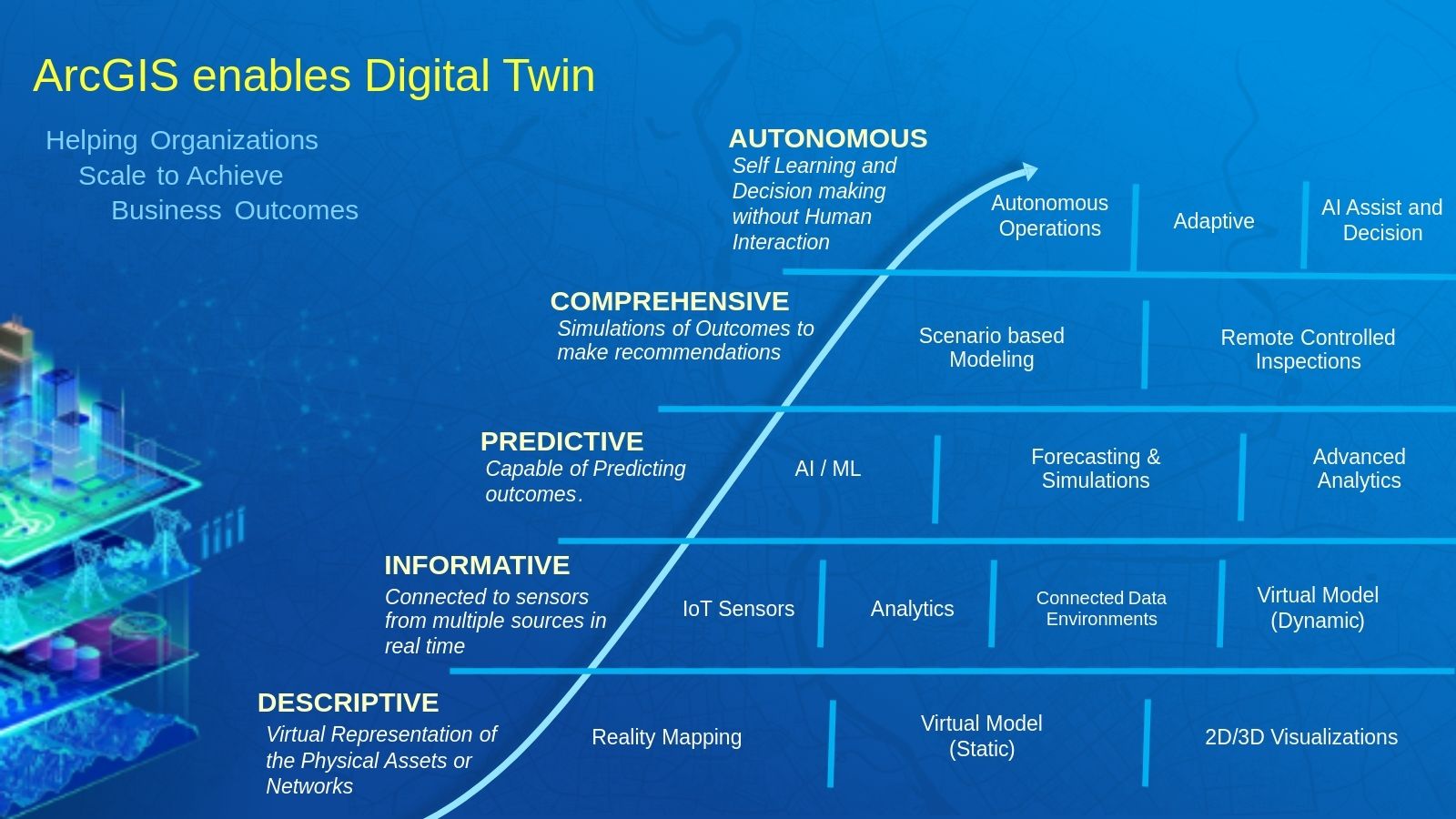ArcGIS—The Backbone of Digital Twins
Article by Esri India
Digital twins create a representation of both natural and built environments, allowing stakeholders to monitor current performance while also exploring and predicting future outcomes. The advantages of digital twins significantly increase when GIS data is incorporated. This integration enhances visualization and analytical capabilities, enabling users to gain valuable insights into various scenarios and their potential impacts. Improved access to data facilitates faster decision-making and boosts workflow efficiency.
Digital Twin Life Cycle
An integrated digital twin enabled through a modern GIS is not one single solution or product—rather, it is an ecosystem of capabilities and applications being bought together by GIS to support holistic and collaborative approaches. It is not one digital twin but rather many digital twins that are integrated and interconnected.
Below are the four elements for managing the information lifecycle for a digital twin:
Data capture and integration are foundational to a digital twin. Organizations need comprehensive, end-to-end data management. They need to capture the data, model it, integrate it, and then manage it and its associated attributes and behaviors throughout its lifecycle.
Real-time and visualizations bring the data to life, taking information and creating a better understanding of what is happening now. Sensor technology enables real-time situational awareness combined with advanced visualization capabilities to virtually represent how the physical components are operating in the real world.
Analyze and predict to move decision-making beyond just understanding the current operational state. Organizations must understand the past and view predictions of the future. They need to simulate and forecast expected outcomes as well as automate the decision-making process.
Sharing and collaboration are enabled via desktop and mobile devices for both internal and external stakeholders. Digital twins are about collaboration, sharing information, and getting it to those who need it, when they need it.
Esri’s ArcGIS enhances data capture and integration, enables better real-time visualization, provides advanced analysis and automation of future predictions, and allows for information sharing and collaboration.
The Five Levels of Digital Twins
Digital twins can be classified into five levels of sophistication, ranging from basic data integration to fully autonomous operation.
Level 1: Descriptive Twin
The descriptive twin serves as a live, editable representation of design and construction data, providing a visual replica of a built asset. Users can choose the information to include and the data to extract, effectively creating a virtual model of physical assets or networks.
Level 2: Informative Twin
Building on the descriptive twin, the informative twin incorporates operational and sensory data. It aggregates and verifies data from various sources, ensuring that systems work together seamlessly and in real-time.
Level 3: Predictive Twin
At this level, the predictive twin leverages operational data to generate insights and forecast outcomes, enhancing decision-making capabilities.
Level 4: Comprehensive Twin
The comprehensive twin takes it a step further by simulating future scenarios and exploring “what-if” questions. It provides outcome simulations that inform recommendations.
Level 5: Autonomous Twin
The most advanced level, the autonomous twin, can learn and act independently on behalf of users. It features self-learning capabilities and can make decisions without human intervention.

ArcGIS uniquely integrates many types of digital models and provides end-to-end capabilities to support a digital twin. It serves as the foundation for digital twins.
ArcGIS Fuels Living Digital Twins
A digital twin brings together many adjacent yet distinct worlds. Central to a living digital twin is the 3D System, which provides clarity, new perspectives, and connectivity to foster sustainable workflows for complex and evolving challenges. What makes ArcGIS unique is that it integrates and connects all these different types of information models and digital twins. ArcGIS allows users to go beyond using very detailed building information models of structure interiors, to see the buildings’ relationships to networks and see all this in context next to the larger city views.
Geospatial digital twins, developed with ArcGIS, can be accessed on mobile devices, web browsers, or through advanced desktop applications from Esri and its partners. Additionally, GIS data drives numerous simulations that reflect real-world dynamics and behaviors. For straightforward analyses, such as assessing shadow impacts on proposed structures, 3D GIS offers intuitive, interactive experiences directly in web browsers. For more intricate analyses, advanced geoprocessing workflows can simulate changes in extensive utility networks, displaying results in user-friendly dashboards.
For decades, ArcGIS has been essential in helping clients to model, analyze, and monitor their assets and systems. Emerging technologies like game engines and real-time data feeds introduce exciting opportunities for creating more interactive experiences, allowing users to explore and analyze their assets and surroundings.
Esri is making substantial investments in reality capture, building information modeling (BIM) integration, building systems integration, and the analysis of Internet of Things (IoT) data. These advancements will play a crucial role in developing the next generation of digital twins with ArcGIS.

Conclusion
The emergence of Industry 4.0 and IoT has accelerated the adoption of the digital twin technology across industries. Currently, the digital twin technology meets the requirements of various users in government as well as private sectors like telecommunications, utilities, etc. Players in the automotive, aerospace, and defense industries appear to be more advanced in their use of digital twins today, while logistics, infrastructure, and energy players are gearing up to follow suit soon. Organizations across verticals are increasingly exploring ways to deploy digital twins in a variety of ways, including in operations, city planning, smart infrastructure, and much more.
GIS technology has a very important role in advancing the idea of creating digital twins for the infrastructure sector in the country. Any digital twin of a fixed asset or real-world system benefits directly from including GIS data about the asset or system and its geographic context. Not only can GIS be used to create digital twins of natural and built environments, but it also can be used to integrate many different digital representations of the real world.
ArcGIS is foundational for any digital twin. It connects different types of data and systems to create a single view that can be accessed throughout the complete project life cycle. ArcGIS enhances data capture and integration, enables better real-time visualization, provides advanced analysis and automation of future predictions, and allows for information sharing and collaboration. There is an array of GIS products that may be utilized for Digital Twin, including ArcGIS Enterprise for integrating drone and LIDAR outputs, GeoBIM, Indoors, UNM and Geoevent Server, and ArcGIS Urban.




Leave a Comment